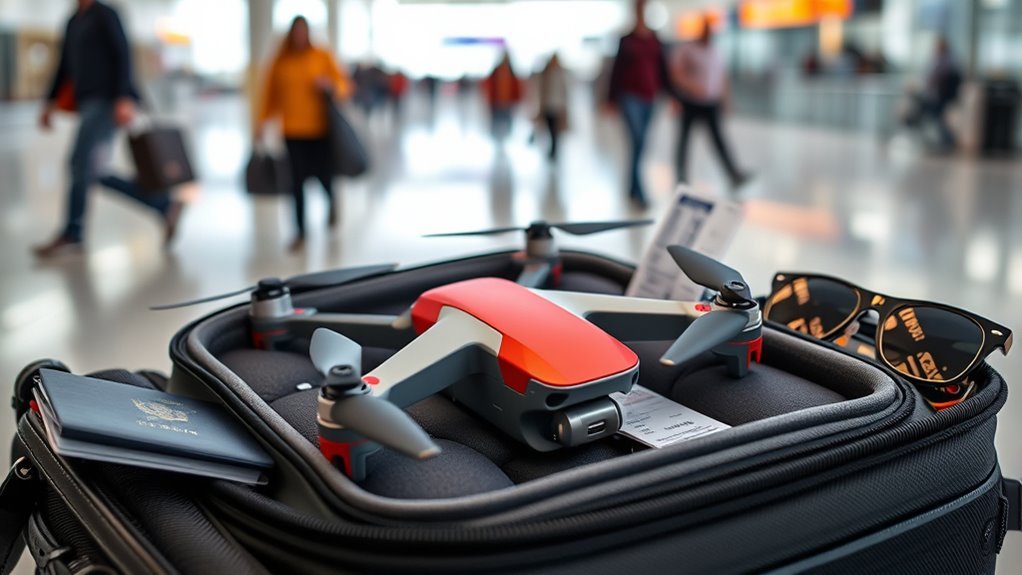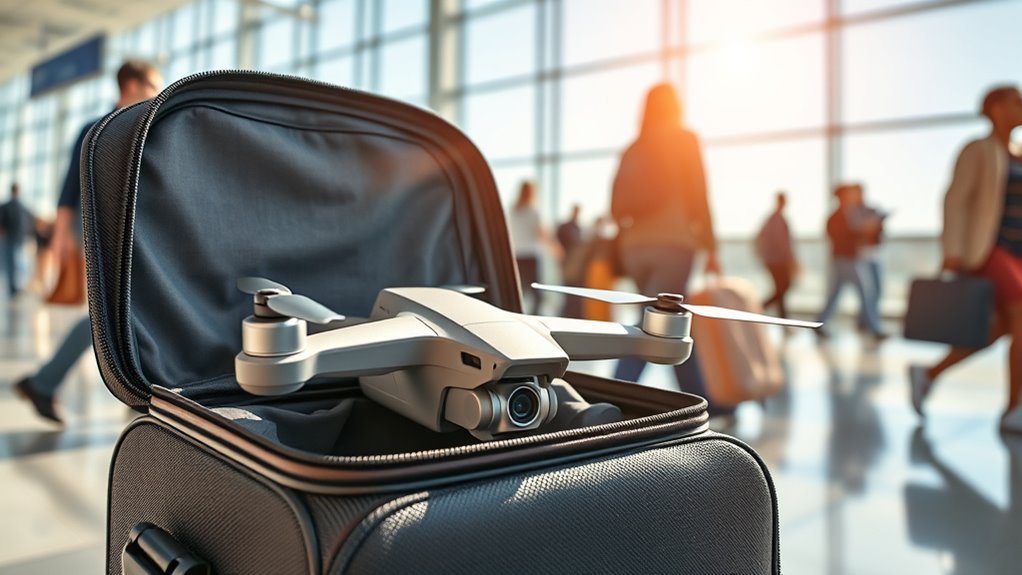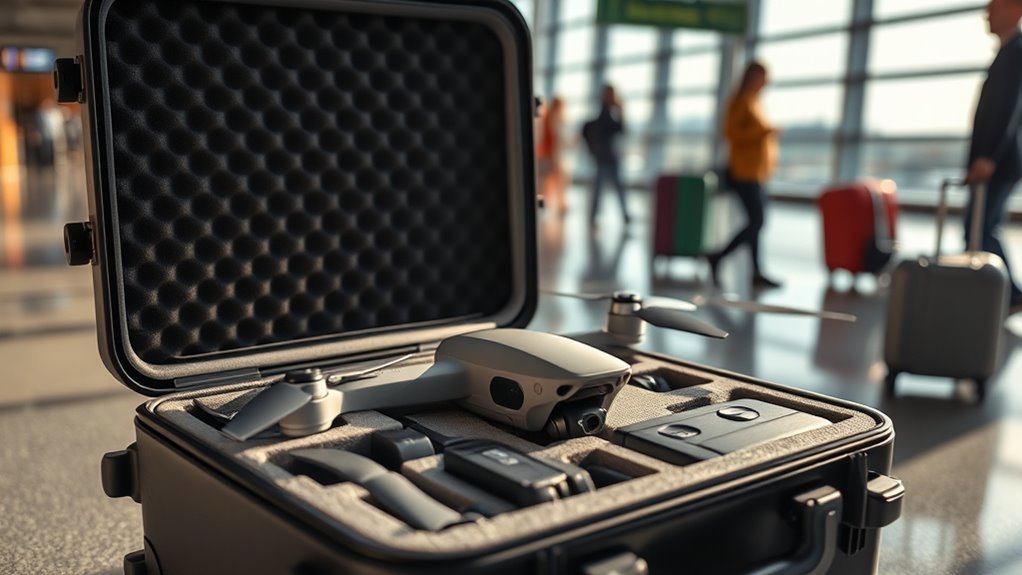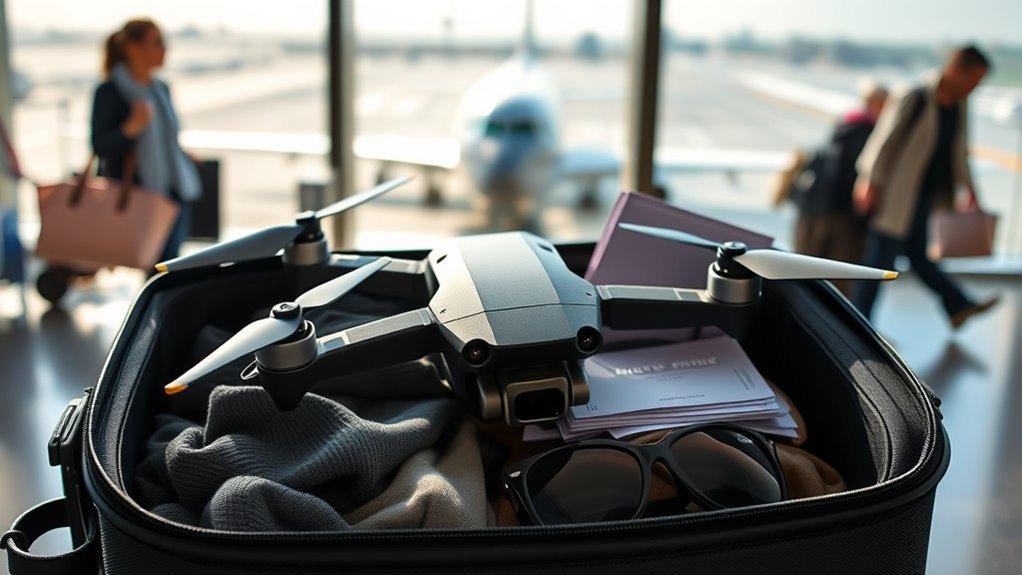Yes, you can take your drone on a plane, but you must follow specific airline and TSA regulations. Each airline has different rules regarding carry-on and checked baggage, and lithium battery restrictions apply. Drones usually need to be accessible for security screening, and it’s important to pack them carefully in a sturdy case. Knowing local laws at your destination is vital too. Keep these guidelines in mind, and you’ll guarantee a smoother travel experience!
Understanding Airline Policies

When you’re planning to travel with your drone, it’s essential to understand the specific policies of the airline you’re flying with. Each airline has its own rules regarding drone transport, and these can vary widely. Some may allow you to carry it in your carry-on, while others might require it in checked baggage. Always check if you need any travel permits or if your drone requires special handling. Additionally, consider getting drone insurance to protect your investment and cover potential damages or losses. Remember, understanding these policies not only guarantees a smoother journey but also keeps you compliant with airline regulations. So, before you set off on your adventure, do your homework to enjoy your freedom without any hassle.
TSA Guidelines for Drones

When you’re traveling with your drone, knowing the TSA guidelines is essential. You’ll need to understand carry-on regulations and battery restrictions to guarantee a smooth experience at the airport. Let’s break down what you need to keep in mind before your flight.
Carry-On Regulations
Although bringing your drone on a plane can be exciting, it’s essential to understand the TSA guidelines for carry-on items. To stay within carry-on limits, make sure your drone dimensions fit your airline’s requirements. Most airlines allow a carry-on bag, typically up to 22 x 14 x 9 inches, so check your drone’s size before packing. If your drone’s compact, you might not face any issues, but always measure beforehand to avoid surprises at the gate. Remember, you’ll also need to keep your drone accessible for security screening, so pack it smartly. With the right preparation, you can enjoy the freedom of capturing stunning aerial shots while traveling. Just play it safe and stay informed!
Battery Restrictions
Before you pack your drone for a flight, it’s essential to understand the TSA guidelines regarding battery restrictions. Most importantly, lithium-ion batteries, commonly used in drones, have specific limits. You can bring batteries with a capacity of up to 100 watt-hours in your carry-on, but if they exceed that, you’ll need special permission. It’s also a good idea to keep spare batteries in their original packaging or with terminals taped to prevent short-circuiting. When it comes to charging options, you can’t use charging stations in the airport, so make certain your batteries are fully charged before you leave. Knowing these battery types and restrictions will help guarantee a smooth journey, letting you focus on capturing amazing aerial shots!
Packing Your Drone for Travel

Packing your drone for travel requires careful consideration to guarantee it reaches your destination safely and complies with airline regulations. Start by disassembling your drone, removing the propellers and any other drone accessories that could get damaged. Use a sturdy case designed specifically for drones, ensuring all parts are cushioned to prevent movement during the flight. Employ packing techniques like wrapping delicate items in soft cloth or bubble wrap. Don’t forget to check the battery regulations; store batteries in protective pouches and pack them in your carry-on. This way, you’ll keep your gear secure while enjoying the freedom of flying in new locations. With the right preparation, you can focus on capturing those breathtaking aerial shots. Additionally, be aware of legal regulations that may affect your ability to fly your drone in certain areas after traveling. Incorporating automated flight modes can further enhance your flying experience once you arrive at your destination.
International Regulations to Consider
When traveling internationally with your drone, it’s essential to understand the diverse regulations that govern their use in different countries. Each nation has unique drone laws that can impact your international flights, so you’ll want to research beforehand. Here’s a quick overview:
| Country | Drone Regulations |
|---|---|
| USA | Must register drones over 0.55 lbs |
| Canada | Requires a pilot certificate for advanced operations |
| UK | Drones must be registered if over 250g |
| Australia | Must adhere to CASA regulations |
| Japan | Requires permission for commercial use |
Failing to comply with these regulations could lead to fines or confiscation. Additionally, understanding registration requirements for your drone type is crucial to avoid any legal issues while flying abroad. Remember to also check for temporary flight restrictions that may affect your ability to operate your drone safely in another country. Stay informed and enjoy the freedom to fly your drone wherever you go!
Battery Restrictions and Safety
When packing your drone for a flight, you need to pay close attention to battery size limitations set by airlines and regulations. Most airlines restrict lithium batteries to a certain watt-hour rating, so it’s essential to check these limits before you travel. Ensuring compliance not only keeps you safe but also avoids potential delays or issues at the airport.
Battery Size Limitations
Most airlines have specific battery size limitations for drones that you need to be aware of before flying. When packing your drone, check the battery capacity and guarantee it doesn’t exceed the airline’s voltage limits. Generally, lithium batteries over 100 watt-hours (Wh) may not be allowed in the cabin, while those between 100-160 Wh often require airline approval. Keeping your batteries under these thresholds not only complies with regulations but also enhances safety during your travels. Always carry spare batteries in your carry-on, as checked luggage restrictions are stricter. By knowing these limitations, you can enjoy the freedom of flying your drone while staying within the boundaries set by airlines. So, double-check those specs before you head to the airport!
Transportation Regulations Compliance
Although understanding transportation regulations can seem intimidating, compliance is essential for safely traveling with your drone. When packing, pay close attention to battery restrictions—most airlines limit lithium-ion batteries to 100 watt-hours. You’ll need to carry these in your carry-on, not checked luggage. Don’t forget to check if you need travel permits for your drone at your destination. Having drone insurance can also protect you from unexpected mishaps during your journey. Before heading to the airport, review airline policies and local regulations to guarantee you’re fully compliant. This way, you can enjoy your travel adventures without worrying about potential penalties or complications. Embrace your freedom, but always keep safety and regulations in mind!
Drone Registration and Licensing
Drone registration and licensing are essential steps for any drone owner looking to fly legally and safely. Understanding the registration process can help you enjoy the skies with confidence. Here’s what you need to know about drone classification and the registration process:
- Determine your drone’s classification: Different rules apply based on weight and purpose.
- Complete the registration process: Register online through the FAA or your country’s aviation authority.
- Display your registration number: Make sure it’s visible on your drone.
- Stay updated on regulations: Rules may change, so keep informed to maintain compliance.
Tips for Traveling With Your Drone
When you’re ready to travel with your drone, planning ahead can make the process much smoother. Start by creating a travel checklist to guarantee you’ve got everything you need, from spare batteries to propeller guards. Before heading out, check airline regulations regarding drones, as policies can vary widely. Don’t forget to pack your drone safely in a sturdy case to prevent damage. It’s also wise to invest in drone insurance; this can provide peace of mind in case of accidents or theft. Finally, familiarize yourself with the local drone laws at your destination to avoid any legal issues. With these tips, you’ll be better prepared to explore the skies freely and capture amazing memories on your journey.
What to Do Upon Arrival at Your Destination
Now that you’ve arrived at your destination, it’s time to get your drone ready for some thrilling aerial adventures. Before you take off, make certain you’re fully prepared. Here’s what to do:
- Check local regulations: Research the rules regarding drone usage in your area to avoid any fines or penalties.
- Verify drone insurance: Confirm your drone insurance is valid and covers you at this location for peace of mind.
- Inspect your drone: Double-check your equipment for any damage and make sure everything’s functioning properly.
- Scout your launch area: Find a safe and open space to fly, ensuring you’re away from crowds and obstacles.
With these steps, you’re set for an unforgettable flying experience!
Frequently Asked Questions
Can I Fly My Drone at the Airport?
Flying your drone at the airport’s like trying to sneak a cat into a dog show. Airport security enforces strict drone regulations, so it’s best to check local laws before attempting to fly there.
What Should I Do if My Drone Is Damaged During Travel?
If your drone’s damaged during travel, check your insurance coverage first. Then, explore repair options with certified technicians. Remember, keeping receipts and documentation can help streamline claims and guarantee you get back to flying sooner.
Are There Age Restrictions for Traveling With a Drone?
You might be surprised to learn that age restrictions for drones often vary by country. Familiarize yourself with local drone regulations and travel guidelines to guarantee you’re compliant and can enjoy your adventures freely!
Can I Bring Drone Accessories in My Carry-On?
Yes, you can bring drone accessories in your carry-on. Just remember to follow packing tips, especially for drone batteries—keep them in their original packaging and under the watt-hour limit for hassle-free travel.
What Happens if I Forget My Drone at the Airport?
If you forget your drone at the airport, contact lost and found immediately. Airport policies vary, but drone retrieval often requires proof of ownership. Don’t delay, as unclaimed items may be disposed of or auctioned off.

